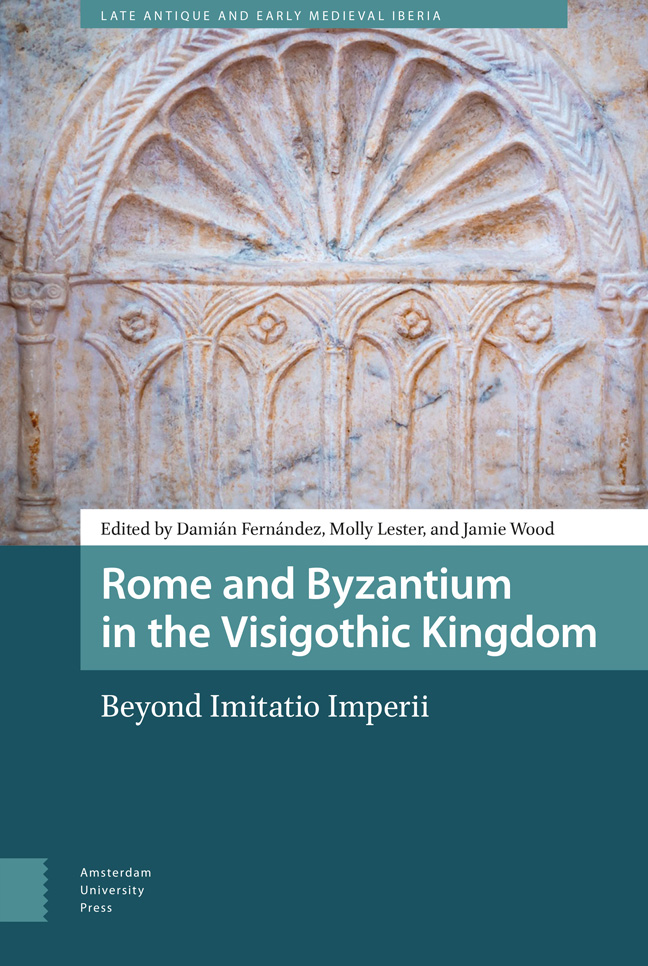Book contents
- Frontmatter
- Contents
- List of Figures and Tables
- Abbreviations
- Acknowledgements
- Maps
- Introduction
- 1 Visigothic Spain and Byzantium: The Story of a Special (Historiographical) Relationship
- 2 The Development of the Visigothic Court in the Hagiography of the Fifth and Sixth Centuries
- 3 Experiments in Visigothic Rulership: Minting and Monetary Reforms under Alaric II
- 4 A Comparison of Roman and Visigothic Approaches to Exile
- 5 The Roman Jewel in the Visigothic Crown: A Reassessment of the Royal Votive Crowns of the Guarrazar Treasure
- 6 Capitalhood in the Visigothic Kingdom
- 7 Making Rite Choices: Roman and Eastern Liturgies in Early Medieval Iberia
- 8 Ethnicity and Imitatio in Isidore of Seville
- 9 Re-imagining Roman Persecution in the Visigothic Passions
- 10 Romanness in Visigothic Hagiography
- 11 Empire and the Politics of Faction: Mérida and Toledo Revisited
- 12 The Agents and Mechanics of Connectivity: The Mediterranean World and the Cities of the Guadiana Valley in the Sixth Century
- 13 Staying Roman after 711?
- Index
4 - A Comparison of Roman and Visigothic Approaches to Exile
Published online by Cambridge University Press: 20 February 2024
- Frontmatter
- Contents
- List of Figures and Tables
- Abbreviations
- Acknowledgements
- Maps
- Introduction
- 1 Visigothic Spain and Byzantium: The Story of a Special (Historiographical) Relationship
- 2 The Development of the Visigothic Court in the Hagiography of the Fifth and Sixth Centuries
- 3 Experiments in Visigothic Rulership: Minting and Monetary Reforms under Alaric II
- 4 A Comparison of Roman and Visigothic Approaches to Exile
- 5 The Roman Jewel in the Visigothic Crown: A Reassessment of the Royal Votive Crowns of the Guarrazar Treasure
- 6 Capitalhood in the Visigothic Kingdom
- 7 Making Rite Choices: Roman and Eastern Liturgies in Early Medieval Iberia
- 8 Ethnicity and Imitatio in Isidore of Seville
- 9 Re-imagining Roman Persecution in the Visigothic Passions
- 10 Romanness in Visigothic Hagiography
- 11 Empire and the Politics of Faction: Mérida and Toledo Revisited
- 12 The Agents and Mechanics of Connectivity: The Mediterranean World and the Cities of the Guadiana Valley in the Sixth Century
- 13 Staying Roman after 711?
- Index
Summary
Abstract
In the Classical and late Roman world, exile was mentioned often in legislation, indicating that it was of particular interest to rulers. Abundant references in literary sources enable us to analyse how legislation was applied in practice, often in response to individual circumstances. There are likewise numerous references to exiles and fugitives in Visigothic legislation, Hispano-Visigothic church canons, and contemporary literary texts. We know concrete details of several particular episodes from narrative sources. However, collectively, these sources suggest that the legal treatment of exiles in the Visigothic kingdom cannot be considered a simple transposition of Roman practices. This chapter aims to determine the relationship between individual cases and Visigothic legislation in order to outline deviations from Roman practice and to understand their potential causes.
Keywords: exile; Late Roman legislation; Visigothic legislation; comparison; case studies
Introduction
For those who were sentenced to exile in the late Roman empire, the punishment entailed removal from their society, their families, and their polities. The penalty of exile was employed to demonstrate to the population as a whole that the behaviour for which the convicted were exiled was absolutely reprehensible. Exile entailed physical exclusion, social shame, and, therefore, a stigma that separated the person from the rest of society. It was not a physical brand but a social one. When the exiled person also had their property and assets partially or totally confiscated or forcibly transferred, they were demoted to a lower level in society, in both their places of origin and exile.
Exile as a judicial punishment, either as relegatio or banishment or as deportation to islands as specific destinations, was a very common practice in the late Roman empire. The barbarian kingdoms of the West also employed exile as a punishment for individuals who were found guilty of various crimes and offences. As in the case of the Roman empire, literary and legal sources constitute our main supply of information on this subject, which make possible numerous studies on exile in these societies.
Several important studies have focused on the extent of Roman influence on Visigothic legislation. However, fewer publications have analysed whether Visigothic kings from the reign of Euric (d. 484) until the end of the kingdom in 711 adopted or modified judicial exile as it existed in the late Roman and early Byzantine empires.
- Type
- Chapter
- Information
- Rome and Byzantium in the Visigothic KingdomBeyond Imitatio Imperii, pp. 97 - 122Publisher: Amsterdam University PressPrint publication year: 2023

